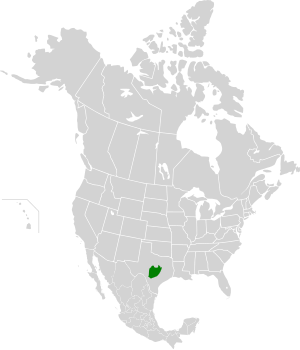A new study of seda-DNA and bone DNA from Hall’s Cave documents the changes over time in the plant and animal communities on the Edward’s Plateau in Texas. Previously, scientists had collected and identified thousands of bones in Hall’s Cave from 56 species of mammals, 30 species of birds, 9 species of amphibians, 3 species of reptiles, and 2 species of fish. The bones date from the Last Glacial Maximum (~20,000 years BP) to the early Holocene (~9,000 years BP). The new study extracted DNA from the bones but in addition took samples of DNA from the sediment. (Scientists call DNA from sediment samples, “seda-DNA.”) Sampling DNA from the sediment has the added advantage of detecting the presence of plant remains that were otherwise unidentifiable, and the presence of animals that perchance left no skeletal remains at all in the cave. For example 2/36 bone samples were from cat but 7/10 sediment samples detected cat. Jaguars and bobcats urinated, defecated, and shed hair in the cave but left no skeletal remains. The seda-DNA samples detected 36 of the 56 species of mammals known to have occurred in the cave from fossil evidence but they found an additional 7 species of mammals as well as additional species of birds not collected as fossils here, including ducks and geese. They also determined which species of woodrat lived in the cave, an identification not really possible by just looking at the bones.
Deer mouse, cottontail rabbit, and eastern woodrat were the most common species of small mammals found in the cave since the Last Glacial Maximum, and these species occurred throughout all climate phases. White-tailed deer and bison were the most common large mammals found in the cave and they too were found throughout all climate phases, though they became less abundant over time. Hackberry and oak were the most common plant species found in the cave, and they were found throughout all climate phases. Hackberry still grows near the entrance of the cave. According to local pollen studies, pine was the most common tree growing on the Edward’s Plateau during the Ice Age, but it is absent from the cave. Pine simply didn’t grow near the cave.

Hall’s Cave.

Location of Edward’s Plateau.

Dendrogram of species found via DNA sampling in Hall’s Cave. From the below referenced study.
The study sheds light on the changes that occurred on the Edward’s Plateau since the Last Glacial Maximum. During the height of the last Ice Age weather patterns differed from those of today–more precipitation fell on southwestern North America whereas southeastern North America was more arid. As a result, the Edward’s Plateau hosted a prairie environment with trees found at scattered locations. Soils were much thicker because dense grass regularly decayed. Deeper soils were good environments for prairie dogs, 13-lined ground squirrels, pocket gophers, and marmots. Common large mammals included camel, pronghorn, and flat-headed peccary that were preyed upon by saber-tooths, dire wolves, and giant short-faced bears. Birds that preferred treeless plains–prairie chickens, upland sandpipers, horned larks–abounded here then.
The environment changed here about 15,000 years ago during the Boling/Alerod Interstadial when temperatures and precipitation increased. The prairie converted to open woodland and forest with widely spaced oak, ash, juniper, walnut, mulberry, and hackberry trees. Plenty of grass still grew between the trees…enough to support a population of horses. Many of the open plains animals disappeared from the record here including the pronghorn, camel, and flat-headed peccary. Black-tailed jackrabbits, northern grasshopper mice, and prairie chickens all left the area as well. However, turkey, bobwhite quail, and barking tree frogs moved onto the Plateau because they liked the newly expanded tree and thicket habitats.
12,900 years ago, during the Younger Dryas cold phase, the climate suddenly became much colder and dryer. Vegetation decreased and the region became desert-like. Small and large mammal and plant diversity decreased. Following the end of this cold phase, temperatures and precipitation increased, though rainfall didn’t increase to the levels of the LGM and Boling/Alerod Interstadial. Soils of the Edward’s Plateau were still thinner than they were during the LGM and today the region is dominated by a plant community of live oak, juniper, and hackberry. Plant and small animal diversity rebounded but large mammal diversity did not. The authors of this paper suggest man is likely responsible. Plant and small mammal ranges adjusted to climate change, and they disappear and re-appear in the seda-DNA samples over time. If not for overhunting by man, the same should hold true for large mammals. 14 species of large mammals that lived on the Edward’s Plateau during the late Pleistocene are either extinct or extirpated from the region.
Plant and animal composition does not stay constant, and the study found some non-analogue components living side by side. Today, white-tailed jack rabbits and barking tree frogs have ranges that do not come close to overlapping, but both species lived on the Edward’s Plateau during the Boling/Alerod Interstadial. Bog lemmings and least weasels ranged much farther south then and co-occurred with species of more southerly affinities. Animal and plant communities are dynamic and always changing.

Range of barking tree frog.

Range of white-tailed jack rabbit. White tailed jack rabbits and barking tree frogs both lived on the Edward’s Plateau during a warm interstadial of the last Ice Age, indicating the existence of non-analogue environments dissimilar to any that occur today.
Reference:
Seersholm, F.; et al
“Rapid Range Shifts and Megafaunal Extinctions Associated with Late Pleistocene Climate Changes”
Nature Communications 2020









